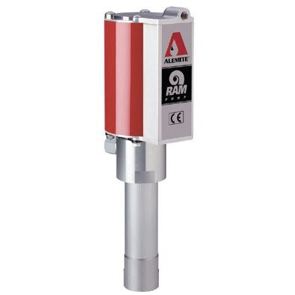First, let’s define pump ratio. Pump ratio represents the effective area of the air motor piston when compared to the effective area of the fluid piston on a reciprocating, piston pump (the type that we commonly sell for oil, grease, gear lube, ATF, etc). For example, on a 5 to 1 (commonly depicted as 5:1) ratio oil pump, the air motor piston is 5 times larger, in effective area, than the fluid piston. It’s easy to visualize this relationship by looking at a 1:1 ratio Pump:

Notice that the air motor and fluid section are the same size.
Here’s a 5:1:

The effective area of the air motor piston is 5 times larger than the fluid piston.
Great! What does that mean for you? It means that for every 1 psi of air pressure that you put to the pump, you get 5 psi of fluid pressure. If the air regulator on your 5:1 pump is set to 60 psi, you’re getting 300 psi of fluid pressure at the pump outlet. You’ll need to account for friction line loss through your piping or tubing, as well any hose reels, dispense valves, etc. We can calculate a line loss for you, and get you dialed in to perfection. However, you can usually go by this chart:
Pump Ratio Disp.Points Max Rec. Line Length Typ. Products Pumped Annual usage
1:1 1 100 Feet Hyd. Oil, Mtr Oil, ATF up to 5000 g
3:1 1-3 250 feet Mtr Oil, Atf, Hydr up to 30,000g
5:1 1-4 500 feet Mtr Oil, Atf, Gear, Hyd up to 30,000g
10:1 3-5 750 feet Mtr Oil, ATF, Gear, Hyd up to 35,000
For Grease, you’ll go with a minimum of a 50:1 ratio pump. For extremely long piping, or high pressure applications, you can go with a 75:1.
If you have any doubts or questions, give us a call.